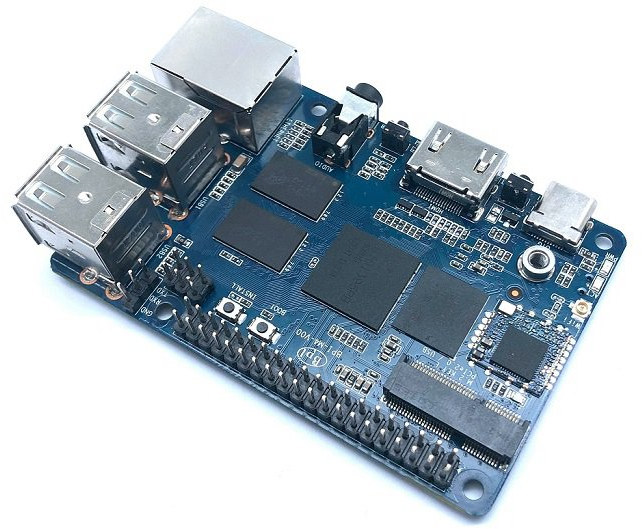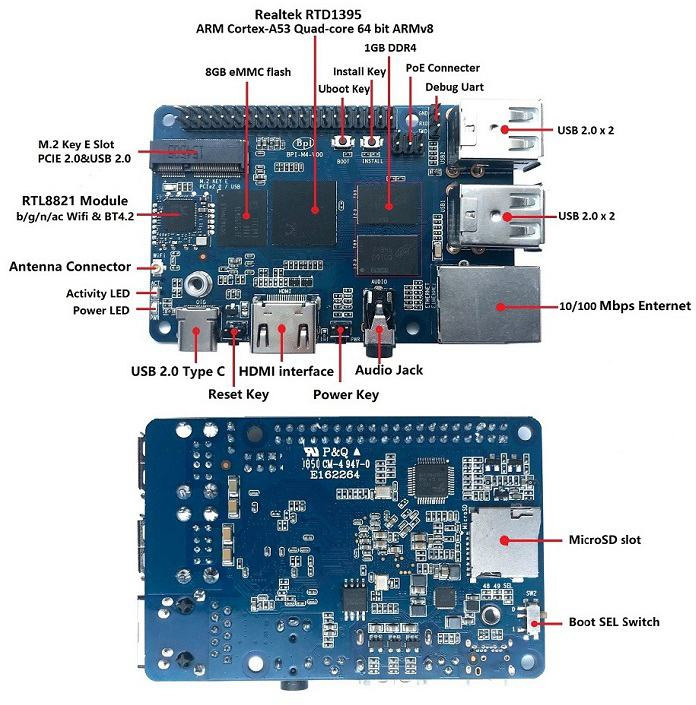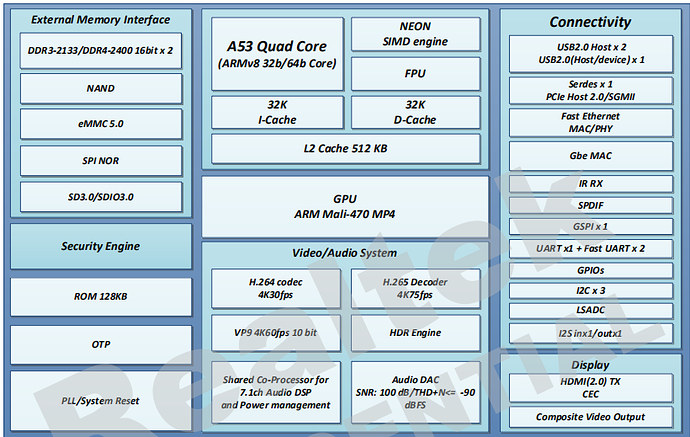Realtek RTD1395 processor is a lower cost version of RTD1295 / RTD1296 processors found in mid-range TV boxes often including HDMI input and output such as Zidoo X9s or LAKE I Home Cloud. The new processor comes with a lower-end Mali-470MP4 GPU and removed some interfaces like HDMI input and native SATA.
So far, we had seen very few hardware platforms built around the processor, but SinoVoIP has just unveiled their latest Banana Pi BPI-M4 board powered by Realtek RTD1395 processor, following Raspberry Pi 3B+ form factor, and adding an M.2 key E socket with PCIe 2.0 and USB 2.0 signals.
 Banana Pi BPI-M4 specifications:
Banana Pi BPI-M4 specifications:
- SoC – Realtek RTD1395 quad-core Arm Cortex-A53 processor with Mali-470 MP4 GPU
- System Memory – 1 GB DDR4 (option 2 GB)
- Storage – 8G eMMC flash (max 64 GB), micro SD slot up to 256GB
- Video Output – 1x HDMI 2.0 port up to 1080p (TBC)
- Audio – Via HDMI port, 3.5mm audio jack
- Connectivity – 100 Mbps Ethernet and 802.11 b/g/n/ac WiFi 5 + Bluetooth 4.2 (via RTL8821 module)
- USB – 4x USB 2.0 host ports, 1x USB 2.0 type C port
- Expansion
- M.2 Key E slot with PCIe 2.0 and USB 2.0
- 40-pin Raspberry Pi compatible GPIO header with UART, I2C, SPI, PWM or power supply
- Misc – Boot selection switch; power and activity LEDs; Power, Reset, Uboot and Install push buttons
- Debugging – 3-pin debug UART header for serial console access
- Power Supply – 5V/2A via USB type-C port or PoE using official Raspberry Pi PoE HAT.
- Dimensions – 92x60mm; Note: Raspberry Pi 3B+ measures 85 x 56 mm, but SinoVoIP appears to have included the connectors for their dimensions
- Weight – 48 grams
 The company now showcases the board with Android 8.1, but a Linux OS is also listed in the specifications without naming the actual distribution used. The Wiki is still very much in process, and only contains some information about the hardware, and only placeholders for the software part.
The company now showcases the board with Android 8.1, but a Linux OS is also listed in the specifications without naming the actual distribution used. The Wiki is still very much in process, and only contains some information about the hardware, and only placeholders for the software part.
Some of you may wonder why SinoVoIP decided to only include Fast Ethernet. The answer can be found in the RTD1395 block diagram below: The chip includes an IP block with a Fast Ethernet PHY and MAC, and an IP block with a Gigabit Ethernet MAC, so they save one Ethernet transceiver chip by going the Fast Ethernet route.
Another oddity in the board’s specifications is the HDMI port support for up to 1080p only. That one may be a mistake because RTD1395 processor comes with an HDMI 2.0 transmitter capable of 4K @ 60 Hz output, as well as a 4K H.264 / 30fps, H.265 / 75 fps, and VP9 / 60 fps video processing unit.
It’s unclear when the board will become available, but the company informed me Banana Pi BPI-M4 pricing will be known by next week.

Jean-Luc started CNX Software in 2010 as a part-time endeavor, before quitting his job as a software engineering manager, and starting to write daily news, and reviews full time later in 2011.
Support CNX Software! Donate via cryptocurrencies, become a Patron on Patreon, or purchase goods on Amazon or Aliexpress. We also use affiliate links in articles to earn commissions if you make a purchase after clicking on those links.






Another crippled board without mainline support. RTD1295/1296 were good enough for building complete media center solution, but without OSS support it’s much better to pay extra for ODROID-H2.
Reading wiki, rather odd HDMI output “1080p capable HDMI port and multi-channel audio output (NO H./X.265 capabilities) “
Yep, I think that part is wrong. 4K output and H.265 should be supported.
I wonder if Banana Pi are mixing up encoding and decoding of video?
What is the point of this board? I dont get it.
No usb 3.0, No gigabit ethernet , yes it has pcie, but I doubt it will have any sort of kernel support in the near future.
These clowns should make their existing W2 solid, instead of making another pointless board ..
Sinovoip is famous for changing the SoC with each SBC. So you get the least possible support one can imagine 😀 How innovative.
Reads 10/100, moves along.
chip just support 100M, if want 1000M ,must use pcie port .
If the block diagram is correct, the chip has a Gigabit Ethernet MAC. You would not need to use PCIe, but just add an external GbE transceiver.
And Lion Wang (SinoVoip CEO) is not even able to give an answer to such statements.
The datasheet mentions: ‘The RTD1395 integrates a 10/100/1000M Ethernet MAC, 10/100M PHY, and optional SGMII. It provides full compliance with IEEE 802.3 compliant Media Access Controller and IEEE 802.3x Full Duplex Flow Control.’ and ‘1000Mbps (SGMII only) operation’.
Maybe SGMII is the culprit why they chose to create hardware that is as underwhelming as any Raspberry Pi while not delivering on the only reason to buy such a RPi: software support and community.
Do you have a link to the datasheet ? Haven’t been able to find one